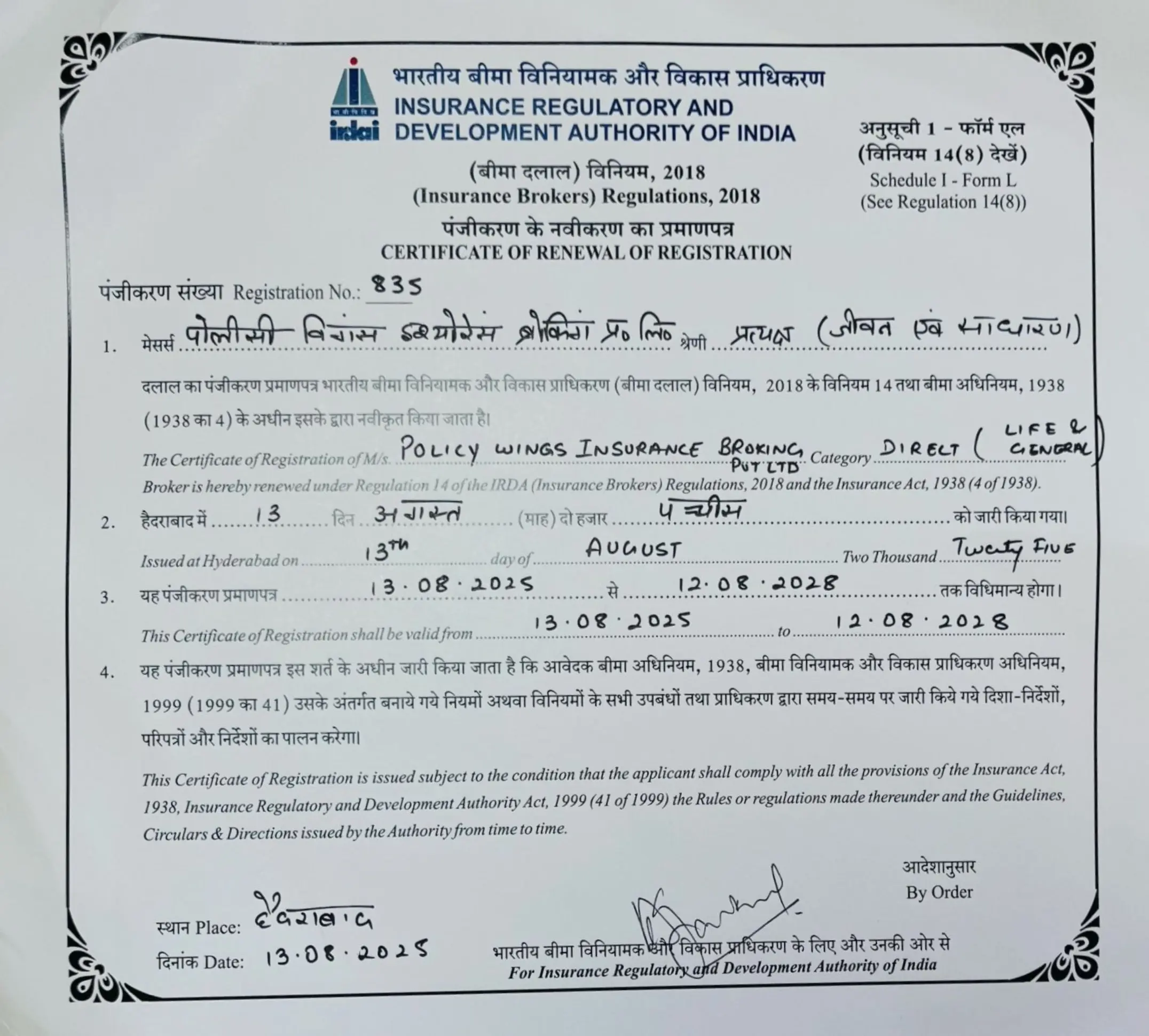20 lakh Health Insurance
20 lakh Health Insurance
What is a ₹20 lakh health insurance plan?
A health insurance that you can purchase for yourself and your loved ones and that has a sum insured of ₹20 lakhs, is a ₹20 lakh health insurance plan. Should there be a need to claim the policy, the maximum reimbursement, or cashless benefits that you can avail of will be limited to ₹20 lakhs. It is one of the most practical policies to buy since the coverage can be ideal for an individual as well as a family floater plan.
Considering the higher expenses related to medical treatments, ₹20 lakh health insurance policy will provide you ample financial cushion against most health emergencies. And even more importantly, it will enable you to seek the best treatment out there, without any concerns about its cost. The health insurance plan will safeguard you against accidents, diseases, and illnesses so that you can lead a healthy life.
Workings of Mediclaim policy for ₹20 lakh sum insured
A Mediclaim policy, with coverage up to ₹20 lakh, is designed to assist policyholders in managing their medical expenses. Various elements make the policy a complete package, such as coverage details, policy duration, premium payments, and claims processing.
When considering the purchase of a ₹20 lakh Mediclaim policy, you’ll be required to pay a specific premium amount to the insurance provider. This premium is typically applicable for a predetermined policy term. Upon reaching the end of this term, you can opt to renew the policy by paying the premium again. It is advisable to maintain your policy for an extended duration to ensure continued coverage for unexpected medical emergencies.
Mediclaim policies commonly encompass expenses associated with hospitalisation due to a range of circumstances, such as critical illnesses, accidents, and surgical procedures. To access these benefits, you must initiate the claim process.
You can select either a cashless claim or a reimbursement claim. In a cashless claim, the insurance provider directly settles the hospital bills, eliminating the need for you to make payments. Conversely, a reimbursement claim necessitates you to settle the hospital bill upon discharge and then provide all relevant bills and medical summaries to the insurance company. They will review the documentation and, upon approval, reimburse you accordingly.
Who should buy health insurance plans for ₹20 lakhs?
Acquiring a health insurance policy with ₹20 lakh coverage can be a prudent choice for a variety of individuals. The following groups can particularly benefit from investing in ₹20 lakh health insurance plan:
1. Unforeseen Medical Emergencies: Individuals who seek a financial safety net for unexpected medical emergencies can find value in this policy, as such situations often strike without warning.
2. People with a History of Health Issues: Those with a track record of medical conditions or a family history of such ailments may find this policy essential, given the increased likelihood of inheriting or developing medical issues.
3. Individuals Leading Sedentary Lifestyles: Individuals who lead sedentary lives are more susceptible to lifestyle-related diseases like hypertension, diabetes, and heart diseases, which can result in substantial treatment costs.
4. High-Risk and High-Pressure Work Environments: Those engaged in high-risk professions or high-pressure work environments should consider a higher coverage health insurance plan to ensure comprehensive protection.
5. Frequent Travelers: Individuals who frequently travel, regardless of their location, can benefit from the versatility and security offered by this policy, which provides coverage wherever they are.
6. Supplement to Employer-Based Plans: If you already have health insurance through your employer but find the coverage inadequate, opting for a ₹20 lakh health insurance plan can provide enhanced protection against the escalating expenses associated with medical treatments.
It is vital to carefully assess your coverage needs and align them with your budget. Additionally, reviewing your family’s medical history can help determine the appropriate coverage level. If you are uncertain about the features and advantages of a ₹20 lakh plan, comprehensive details are available to assist you in making an informed decision.
Premiums for ₹20 lakh health insurance plan
In recent years, the combination of a global pandemic and increased medical costs has placed significant financial strain on many families when it comes to covering medical expenses. Given these circumstances, selecting the right health insurance plan becomes paramount for safeguarding your financial well-being. Opting for a health insurance policy with a coverage of ₹20 lakh can be a prudent decision, as it not only provides comprehensive coverage but also boasts reasonable premiums.
The premium for a ₹20 lakh health insurance policy is dependent upon several factors, including the insured individuals’ ages, coverage, and current place of residence, among others. If you choose to pay the premium annually, you can obtain this coverage for less than ₹10,000. Fortunately, most insurance providers now allow the purchase of plans on small monthly payments. You can secure a ₹20 lakh health insurance plan for as low as ₹750 a month.
Features of ₹20 lakh medical insurance
Opting for a ₹20 lakh health insurance policy provides access to a range of features and benefits. Here are key features to prioritise when selecting a health plan:
1. Policy Premiums: While policy premiums are crucial, they shouldn’t be the sole criterion for selection. Look for a policy offering adequate coverage without excessively high premiums. Balancing cost with coverage is key to making an informed decision.
2. Network Hospitals: Insurance providers have partnerships with specific hospitals, offering policyholders better benefits. Treatment and discharge at these network hospitals often come with zero out-of-pocket expenses, as the insurer settles the bills directly. Therefore, it’s essential to review the list of network hospitals when choosing a policy.
3. Pre and Post-Hospitalisation: Medical expenses can take place beyond hospitalisation. Patients may require medications and therapies before and after hospitalisation. Health insurance typically covers these pre-hospitalisation (30 days) and post-hospitalisation (60 days) expenses, aiding in quicker recovery.
4. Pre-existing Diseases: Pre-existing conditions refer to medical conditions existing before a policy purchase. Insurance companies typically impose waiting periods for coverage of such conditions. Look for policies either covering pre-existing diseases or having minimal waiting periods to ensure comprehensive protection.
5. Co-payment: Some plans include a co-payment clause, requiring the policyholder to contribute a percentage of the claim amount. For instance, with a 10% co-payment clause, a ₹2 lakh claim would require a ₹20,000 out-of-pocket payment. It’s advisable to consider policies without co-payment clauses to avoid such expenses.
6. Room Rent: Many insurers impose limits or sub-limits on room rents. Given that room charges form a significant part of medical bills, policies without room rent caps are preferable.
7. No Claim Bonus (NCB): NCB rewards policyholders for claim-free years. Accumulated NCB can result in either premium discounts or an increase in the sum insured. This bonus typically ranges from 10% to 50% for each claim-free year.
Choosing a ₹20 lakh health insurance policy offers you access to various advantages. Prioritising these features ensures you select a policy that not only fits your budget but also provides comprehensive coverage for your healthcare needs.
Higher sum insured plans v/s low sum insured with Top-up plans
The presence of a range of health insurance plans and different sums insured can be a bit confusing at times. It is possible to get confused between buying a policy with a higher sum insured or using a top-up plan on a policy with a low sum insured. Here are the primary differences between both, to help you decide better.
| Considerations | Low sum insured + Top-up | High sum insured |
| Policy premium | This combination is a more affordable option due to the low sum insured by the base plan. | Has a higher policy premium due to a higher sum insured |
| Claim process | Easy to follow claim process but you might not always have access to cashless benefits | Easy to follow claim process and mostly cashless |
| Deductibles | Deductibles can be a bit high and the top-up will only come into effect, once the deductible is paid by the insured | Low deductibles |
Both plans have their pros and cons. If you already have a health insurance plan with a lower sum insured, adding top-ups would be a more efficient way. However, for individuals buying a new plan, opting for a higher sum insured plan is preferable, due to better coverage and increased medical costs.
Benefits of buying ₹20 lakh health insurance
A health insurance plan with a ₹20 lakh sum insured guarantees that you and your loved ones will have ample coverage to confront unforeseen medical contingencies. Here are some benefits of opting for such a plan:
1. Cashless Payments: One of the significant advantages of buying a ₹20 lakh health insurance plan is the convenience of cashless benefits. On treatment at a network hospital designated by the insurance provider, you won’t need to make payments. The insurance provider and the hospital will directly settle the bills on your behalf.
2. Comprehensive Coverage: A plan with a ₹20 lakh sum insured ensures that you and your family have substantial financial support to address unexpected medical challenges. Such a plan typically covers various expenses, including hospitalisation charges, consultation fees, surgical expenses, nursing fees, and more. This comprehensive coverage preserves your savings, as the policy caters to these expenses.
3. Critical Illness: ₹20 lakh health insurance plan provides robust protection against critical illnesses, such as heart attacks, paralysis, cancer, and others, which often require substantial treatment costs. Additionally, you can opt for a critical illness rider along with the plan. In the event of a critical illness diagnosis, the insurance provider pays a lump sum amount that can be utilised for treatment.
4. Tax Benefits: Premiums paid for a ₹20 lakh health insurance policy offer tax benefits. According to Section 80D of the Income Tax Act of 1961, the premiums you pay can be deducted from your total taxable income. For individuals under 60 years old, the maximum deduction limit is ₹25,000, while for those aged 60 and above, it is set at ₹50,000.
5. Family Floater: A health plan with a ₹20 lakh sum insured is ideal for a family floater plan. It ensures that every family member can benefit from a higher sum insured, using it to address health-related issues throughout the year. This increased coverage removes financial stress during most medical emergencies, providing peace of mind for you and your family.
Who needs a ₹20 lakh health insurance plan?
Eligibility & documents required to buy a ₹20 lakh health insurance
You must meet the following eligibility criteria to be able to buy ₹20 lakh health insurance policy.
1. Age limits
A policyholder must be at least 18 years old and up to 65 years old. For children, the age limits are set between 90 days and 18 years.
2. Pre-medical tests
Some insurance providers require the policyholders to undergo medical tests. The tests are usually diagnostic ones like urine tests, blood tests, tests for major organs, etc.
Apart from the above criteria, you will need to submit certain documents to be able to purchase a plan.
◦ Proof of address such as utility bill, driver’s license, Voter’s ID, passport, Aadhar card
◦ Proof of age such as birth certificate, PAN card, Aadhar card, passport, mark sheets
◦ Proof of identity such as Aadhar card, passport, driving license, PAN card
◦ Passport size photograph
◦ Any other existing medical records
What’s covered under ₹20 lakh health insurance?
A health insurance plan with ₹20 lakh coverage provides extensive protection for you and your family. Here are some of the typical coverages offered by a ₹20 lakh health insurance plan:
1. Expenses related to diagnostic tests
2. Cost of pre-hospitalisation
3. Cost of post-hospitalisation
4. Cost of organ donation
5. Cost of daycare treatments
6. Cost of ambulance
7. Ayush treatment
8. Cost of inpatient treatment such as room rent, nursing charges, medications, etc.
9. Cost of doctor consultations
What’s not covered under ₹20 lakh health insurance?
Though a ₹20 lakh health insurance plan covers a lot of grounds, there are a few elements that it does not cover. The following are some of the exclusions of a ₹20 lakh health insurance plan.
1. Dental treatments
2. Congenital diseases
3. Self-inflicted injuries or attempt to suicide
4. Alternative treatment costs for acupuncture and acupressure
5. Cosmetic treatment
6. Medical conditions due to abuse of alcohol, intoxicating substances, drugs, etc.
It is highly advisable that you review the policy documents and go through the inclusions and exclusions of a policy before buying one. Being aware of them will ensure that you can claim the policy without any worries of rejection.
How to buy a ₹20 lakh health insurance policy?
It is much easier to buy a ₹20 lakh health insurance policy these days without you even having to visit the local insurance provider office. Here is all that you need to do.
1. Visit the website or smartphone app of your preferred insurance provider or insurance aggregator.
2. Select the health insurance option on the website or app.
3. Look for a health insurance plan with the sum insured of ₹20 lakh.
4. Proceed with the purchase of the health insurance plan.
5. Provide your details such as name, contact information, age, etc.
6. View the list of add-ons to find an add-on that would add value or coverage to the policy.
7. Once you are happy with the coverage and premiums, proceed to complete the payment.
8. After completing the payment, your insurance provider will send you a copy of the policy to your registered email address.
Calculation behind purchasing a ₹20 lakh health insurance plan
Before the purchase of a ₹20 lakh health insurance policy, there are a few calculations that you must keep in mind. The following are some of the major ones.
1. Tax deductions
Section 80D of the Income Tax Act of 1961 allows individuals to claim tax deductions on premiums paid for health insurance policies. As per the section, you can claim a maximum deduction of ₹25,000 for a policy for yourself, your children, and your spouse, provided everyone is below 60 years old. Additionally, you can claim a deduction for your dependent parents and the same limits apply to them as well. For individuals and parents above 60 years, the limit is set at ₹50,000. Thus, the maximum deduction stands at ₹1 lakh.
2. Premium
It should not come as a surprise that insurance providers consider a lot of factors when they issue a health insurance policy. They look at the medical history of the applicant, family health history, age, location, lifestyle, etc. Also, factors such as individual plans and family floater plans play a crucial role in the policy premium. Lastly, the sum insured also sways the policy premiums. A policy with ₹20 lakh coverage will be a bit more expensive as compared to a policy with a lower sum insured.
3. Co-payment
Insurance providers can have a clause of co-payment while issuing health insurance policies. If your policy has a co-payment clause, you will end up paying a certain percentage of the total claim amount. For example, a 10% co-payment clause would result in ₹50,000 out-of-pocket expenses on a claim of ₹5 lakhs. It is better to avoid plans that have co-payment clauses.
4. Deductible
A deductible is a mandatory voluntary payment that you agree to pay on each policy claim. While buying a new health insurance policy, you can decide on the deductible amount that you are willing to pay. Though it is not mandatory to opt for deductibles, they can help you reduce the policy premiums by a considerable margin.
Reasons to go for ₹20 lakh health insurance in India
If you are still on the edge, thinking whether you should or should not buy a ₹20 lakh health insurance policy, here are some compelling reasons to do so.

Health insurance policies provided by employers might not be enough considering the exponential rise in the cost of healthcare over the past few years.

There has been an uptick in the number of diseases that can be directly related to sedentary lifestyles. Diseases such as high blood pressure, diabetes, heart disease etc. are on the rise.

If you are still in your 20s or 30s, buying a ₹20 lakh health insurance plan will turn out to be more affordable. Thus, allowing you better coverage in the future years.

Medical inflation is usually higher than the average inflation. In other words, a procedure would cost more a couple of years down the line than it does today. A ₹20 lakh health insurance policy will have you better prepared.
How does the 20 lakh health insurance plan work?
Once a policyholder is hospitalised, the ₹20 lakh health insurance plan takes effect. It provides coverage for the insured’s medical expenses, up to a maximum limit of ₹20 lakhs. In cases where the insured informs the provider about a planned medical procedure or treatment, the policy allows for cashless payments. Thereby making the medical ordeal seamless and letting the insured focus on recovery rather than expenses.
Alternatively, if the insured receives treatment at a non-network hospital, they can submit all the relevant bills. The insurance provider will then review and approve eligible expenses. It’s important to understand that only medical conditions specified as covered by the policy are eligible for a claim, as conditions listed in the exclusion section will not be covered by the provider.
Factors influencing the 20 lakh health insurance premium
Insurance providers take into consideration quite a few factors to decide on the policy premium. The following are some of them.
1. Coverage
It is a primary factor in deciding on the policy premium. Opting for a policy with a higher sum insured will result in a higher premium as well.
2. Age
A health insurance policy is no different than other insurance policies. Buying a plan during your early years will result in significant savings. Since the risk associated with younger age is less. Conversely, buying the same policy at an older age will set you back by a fair bit.
3. Deductibles
You can opt for deductibles if you want to bring down the policy premiums. However, one must be careful with the deductible amount. Setting a value too high will result in out-of-pocket payment every time you file for a claim.
4. Lifestyle choices
People who consume alcohol and smoke will end up paying a slightly higher policy premium than people who do not.
5. Medical history
If you have any pre-existing conditions, the chances are high that you will end up paying a higher policy premium.
How to pick the perfect 20 lakh health insurance plan?
It is important to choose the right health insurance plan since it can be a differentiating factor in the future. To help you choose the perfect ₹20 lakh health insurance, we have curated a simple list of factors to consider.
1. Coverage
Apart from a considerable sum insured, it is important to go through the coverage on offer of a health insurance policy. Look for any sub-limits or caps when it comes to inpatient treatment and other types of coverage as well such as daycare procedures, domiciliary treatment, etc.
2. Exclusions
You must not skip this step. Make sure to traverse the exclusion list of a policy. It will help you file a claim more accurately and prevent you from unwanted claim rejections.
3. Network hospitals
Visiting a network hospital or an insurance provider makes the entire ordeal much simpler. You can opt for cashless service and in some cases, even pay lower prices for expenses as well. A quick look at the network hospital list would help you identify if your preferred hospital(s) is on the list.
4. Copayment
Some insurance policies would require you to pay a copayment on the policy claims. It is advisable that you look at the copayment clause and avoid opting for such policies if you can.
5. Pre-existing conditions
If you already have a pre-existing medical condition, make sure to verify if the same is covered as a part of the policy. Look at the waiting period for the condition before it can be covered by the policy. a lower waiting period is preferable.
To Sum Up!
A ₹20 lakh health insurance policy can be a differentiating factor when it comes to hospitalisation, considering the skyrocketing medical expenses. It will prepare you better for any future medical contingencies.
Frequently Asked Questions
Buying a ₹20 lakh health insurance policy will help you prepare better for any unforeseen medical contingencies in the future.
While it is not mandatory, opting for add-ons can enhance the policy coverage considerably.
Yes. Most insurance providers offer multiple payment options and frequency of payments to facilitate easier buying.
Leading Health Insurance Companies





Latest Blogs
Introduction Understanding how much car insurance costs in India and how insurers arrive at that car insurance price can save you money and stress. This guide explains what drives premiums, how to use a car insurance premium calculator, recent regulatory changes you must know and practical ways to compare and reduce your vehicle insurance cost India wide, written for Policywings readers who want fast, actionable clarity. What determines your car insurance premium Insurers price policies based on predictable risk drivers and choices you make when buying cover. Key factors are: Insured Declared Value (IDV): the vehicle’s current market value. Vehicle age, variant and make: luxury or performance cars cost more to insure. Cubic capacity/power and usage: private vs commercial usage affects third party rates. RTO location and registration details: premiums vary by city/zone. Claim history and No Claim Bonus (NCB): a claim free history lowers the own damage premium. Addons and deductibles: extras like zero depreciation or road side assistance raise premium; higher voluntary deductibles lower it. These factors are built into online car insurance premium calculators offered by insurers and aggregators to give instant estimates. Use them to run multiple scenarios (change IDV, addons, voluntary excess) so you can compare apples to apples. How third party and comprehensive premiums differ In India you buy either: Third party liability cover: mandatory by law; it covers legal liability for damage to others. Comprehensive (third party and own damage): includes repair/replacement for your vehicle (subject to deductibles and exclusions). Third-party premium rates are set by government notifications (in consultation with IRDAI) and often published as standardized rates for different engine sizes and vehicle classes. Own damage pricing is underwritten by insurers, so this is where most premium variation occurs. If you want the lowest car insurance price, compare the own damage component across insurers while ensuring the third party meets statutory requirements. Recent legal and regulatory updates every buyer should know Regulation in motor insurance has evolved to increase transparency and consumer protection. Important recent points: Multi year third party requirement for new vehicles: regulators and central government guidelines have promoted offering long term third party covers (for example three years for new private cars and five years for two wheelers) as standard options at purchase; own damage cover can be bought annually or as per insurer offerings. This affects upfront car insurance price calculations for new registrations. Standardisation of certain rules: IRDAI initiatives have pushed for uniform No Claim Bonus grids and clearer claim handling timelines which can reduce variability between insurers for those elements of premium calculation. Government-set third party tariffs: the Ministry of Road Transport and Highways (in consultation with IRDAI) notifies third party premium slabs; these remain outside an individual insurer’s pricing freedom. Expect changes when such notifications are updated, especially in response to inflation or claim trends. Recent judicial developments: courts have clarified aspects of who can claim under motor insurance and liability interpretation in accident cases; such rulings can influence claim outcomes and thereby affect insurer pricing over time. Keep an eye on major judgments that may broaden compensable heads or alter settlement practices. Use a premium calculator: the right way An effective car insurance premium calculator does more than spit a number. To get useful quotes: Enter exact vehicle make, model, variant and registration year (mismatches produce wrong IDV). Try at least three different IDV settings (market value, slightly lower, slightly higher) to see premium sensitivity. Toggle addons and voluntary deductibles to understand incremental cost for each benefit. Compare results from an insurer’s calculator and an aggregator: aggregators show side-by-side options quickly, insurers’ calculators sometimes reflect exclusive offers. Aggregators and insurer calculators are widely available and free; use them to shortlist 2 to 3 policies before buying. Practical tips to lower your vehicle insurance cost in India Maintaining and claiming judiciously: preserving NCB yields the single biggest discount on the own damage portion. Opt for higher voluntary deductibles if you can afford small repairs out of pocket. Avoid unnecessary addons, buy only what you will use. Fit approved antitheft devices and inform the insurer: some companies offer OD discounts. Bundle policies (home and car) with the same insurer if discounts apply. Compared at renewal: switching insurers can save money but ensure portability of NCB and check exclusions. Conclusion Confirm whether your new car needs a multi year third party policy at purchase and how that affects upfront cost. Verify IDV and inclusions for total loss/theft scenarios (ask how RC cancellation is handled in write offs). Check the fine print for sub limits (engine, electrical parts) and depreciation tables. Keep documents that prove past NCB and claim history: concealment can lead to claim repudiation. Getting the best car insurance price is mostly about comparison and a few smart choices: use premium calculators to model scenarios, understand the split between statutory third party costs and insurer priced own damage premiums and stay updated on regulatory changes that affect policy duration and claim handling. Policywings recommends running at least three online quotes and reading the policy wordings before you commit, small differences in addons and IDV can change your outlay significantly at the time of claim.
...Introduction In today’s digital age, e-commerce has become a support system for market growth in India but the opportunity comes with risk. For any online business, securing the right insurance cover is important to protect assets and navigate evolving legal regulatory compliance. Requirements of E-commerce Insurance Having an online business means having more layers of risk than many realize and these risks can be product defects, data breaches, shipping damage, intellectual property claims and regulatory exposure. Without adequate insurance, a single legal claim or regulatory penalty can gravely damage finances or harm reputation. Ecommerce insurance India isn’t just a protection but in many cases it becomes a legal requirement under consumer protection rules, data protection laws, product safety regulations, etc. Risk Covers Every Online Business Should Know About: Product Liability Insurance: you can be held liable for damage caused by defective products when you sell goods from third party suppliers as well. Under the Consumer Protection Act 2019, sellers and service providers can face product liability claims for injury, damage or death caused by a product even if you don’t manufacture it yourself. General Liability Insurance: This covers third party bodily injuries and property damage caused by business operations. For example a customer coming to your warehouse/store or damage caused during delivery handled by you, etc. Professional Liability/Errors and Omissions Insurance: If your business offers services (like custom printing, consulting or design) or misrepresents product features (e.g. advertising claims), mistakes or omissions can give rise to legal action. This insurance helps cover legal defence costs, settlements or regulatory fines. Cyber Liability Insurance: Given that nearly every e-commerce business processes personal data, payment information or maintains customer-facing platforms which can lead to real threats like incidents of hacking, data breach or ransomware. Cyber insurance covers breach notification costs, liabilities arising from loss, misuse of data and even business interruption arising from cyber incidents. Business Interruption Insurance: Disasters (like natural calamities, fire, flood), technical failures or cyber attacks can drive an e-commerce company to discontinue operations. Business interruption cover helps replace lost income, pay fixed costs which can help you survive through downtime. Cargo/Transit/Shipping Insurance: Goods in transit are exposed to damage, theft or loss. For e-commerce companies depend significantly on logistics and delivery and mainly with third party carriers then shipping or cargo insurance can protect your goods until they reach the customer or warehouse. Commercial Property/Inventory Insurance: If you maintain warehouses or stock inventory then physical threats like fire, theft, natural disasters can cause huge losses. Covering property, inventory and equipment is important. Regulatory, Fines & Penalties Insurance: You may face regulatory penalties (under data protection law, consumer protection rules or standards violation) as laws are strengthened. Some insurance products are starting to cover penalties or legal compliance costs. Legal Changes & Compliance Trends Influencing Insurance Requirements Consumer Protection Act, 2019 & Product Liability: The Act introduced a statutory product liability establishment (Sections 82 to 87) which obligates manufacturers, sellers, service providers to compensate consumers for damage or harm caused by defective products. Sellers on e-commerce platforms (inventory model or marketplace model) are included particularly where they have exercised control on labeling, packaging, storage, inspection or warranties. Consumer Protection (E-Commerce) Rules, 2020: These Rules require e-commerce platforms to set forth certain information (like return policy, refund policy, warranty, guarantee, country of origin or expiry dates) and to abstain from unfair trade practices. Noncompliance can cause penal action. This raises exposure to legal risk for online businesses. Bureau of Indian Standards (BIS) Compliance/Quality Control Orders: BIS enforcement actions in 2025 have included seizure of products stored in warehouses of e-commerce giants that lacked needed certification. This establishes that platforms and sellers can be held liable even before sale. Making sure product safety and conformity is mandatory. Digital Personal Data Protection Act, 2023 (DPDP Act) (Not fully in force in certain respects but it’s important): This law imposes obligations on “data fiduciaries” (entities collecting/processing personal data). Main provisions include consent, purpose limitation, data subject rights and penalties can be very high for serious breaches. E-commerce businesses require reexamination of data collection, retention and data breach response. This raises cyber/privacy risk notably. Proposed Amendments to E-Commerce Rules: Draft changes include making registration with DPIIT required for all e-commerce entities (which also includes foreign entities that want to operate in India), enhancing related party seller restrictions, extra duties on identification and transparency. Noncompliance risk increases when these come into effect. Strategic Approach for Building an Insurance Portfolio: Start with main covers like product liability, general liability, cyber & property insurance. Add secondary covers like transit/cargo or professional liability and when scale rises then add regulatory risk as optional addons. Team up with insurers who understand e-commerce and those who know marketplace models, cross border shipping and digital assets. They will understand your risk profile much better and provide adequate cover instead of typical covers. Time to time review insurance as business grows: more SKUs, higher sales, more complex logistics or international clients will change exposure and may require more limits or new covers. Conclusion Ecommerce insurance in India is a strategic move and legally essential. With laws like the Consumer Protection Act 2019, Consumer Protection (E-Commerce) Rules 2020, BIS Quality Control Orders and the upcoming enforcement of the DPDP Act, your risk dangers are rising. The right insurance portfolio that includes product liability, cyber risk, general liability, business interruption, cargo transit and more will protect your business and also build trust in consumers and partners.
...Introduction Buying car insurance is no longer just about ticking the “third party” box. Many owners today evaluate addons such as bumper to bumper (commonly called “zero depreciation”) to reduce out of pocket repair costs. But what happens once your car crosses the 5 year mark? This article explains zero depreciation insurance eligibility in India, what IRDAI endorsed wordings say and whether bumper to bumper insurance after 5 years is a smart buy, specifically for Policywings readers who want clear, practical guidance. What “bumper to bumper”/zero depreciation actually covers Bumper to bumper and zero depreciation addons are designed to eliminate the depreciation deduction applied during claim settlement for replaced parts, especially plastic, rubber and fibre components that wear out fast. In plain terms: if you have the add-on and your claim is admissible, the insurer pays the part replacement cost without deducting the normal depreciation. This improves claim value but increases your premium at renewal. Age limits and regulatory wording you should know There is no single nationwide rule that every insurer follows; eligibility depends on insurer product rules and the specific addon wording. However, many major insurers cap zero depreciation eligibility to the earlier years of the car’s life (typically up to 5 years). At the same time, IRDAI endorsed endorsement wordings used by public insurers sometimes specify different age slabs for example, a nil depreciation endorsement used by Oriental Insurance states cover is available for vehicles whose age is less than or equal to 6.5 years on policy inception and limits certain claims to the first two partial loss claims in a policy year. That demonstrates insurer discretion and differing product design. Is bumper to bumper available after 5 years in India? Short answer: sometimes. Most insurers stop offering traditional zero depreciation addons once a car is older than 5 years, but some insurers extend similar covers to older vehicles with conditions (higher premium, limited claim count or capped parts). A few market players advertise options up to 7 or even 10 years for “bumper to bumper” type covers, but those products are rarer and usually more expensive. Always confirm the exact eligibility at renewal, because availability varies by insurer and by the addon wording. Recent regulatory or compliance notes (what changed and what matters) IRDAI continues to standardize endorsements and expects insurers to disclose addon limits, age slabs and exclusions clearly at the point of sale and renewal. The Oriental Insurance nil depreciation endorsement is an example of a standardized wording that spells out age calculation, claim limits and exclusions, a useful template that other insurers echo. Also remember third party liability insurance remains legally mandatory under the Motor Vehicles Act; addons are voluntary enhancements to your comprehensive cover, not substitutes for statutory protection. Practical checklist: should you buy bumper to bumper after 5 years? Consider your car’s IDV (insured declared value). If the IDV is already low, a higher premium for zero dep may not give proportional benefit. Evaluate typical claim cost. If most past claims on your model involve plastic/fibre parts (bumper, headlights, trims), zero dep can save materially. Check limits: some policies restrict zero dep to the first one or two partial loss claims per year, read the renew offer carefully. Compare alternative addons: glass cover, engine protection and consumables cover may be cheaper and address the exact exposures you face. Factor in No Claim Bonus (NCB) and deductibles, a frequent small claim could erode NCB benefits and make the addon less attractive. When it’s usually worth it Bumper to bumper is cost effective when: the car is driven in high risk environments (city traffic, rough roads), replacement parts for your model are expensive and you value cashflow certainty for repairs. For cars with higher cosmetic replacement costs (modern plastic bumper assemblies, advanced headlamp units), the addon often pays back quickly in a single mid sized claim. When to skip it If your vehicle’s IDV is low, you drive sparingly, repairs are usually minor or your budget prioritises keeping premiums down, skip the addon or look for targeted covers (glass/engine/consumables) instead. After 5 years, many owners find targeted riders offer a better premium to benefit ratio. How to shop at renewal Ask insurers explicitly about “bumper to bumper insurance after 5 years India” options and get the precise endorsement wording. Compare at least 3 proposals for premium, claim limits and exclusions. Confirm whether mid term inclusion is allowed (many endorsements prohibit mid term additions). Keep record of prior claims and NCB, they affect pricing. Conclusion Bumper to bumper (zero depreciation) after 5 years can be available but is not universally offered; when it is, it often comes with stricter terms and higher cost. The decision should be pragmatic: weigh IDV, typical repair costs for your car model, claim frequency and the exact addon wording at renewal. For many 5+ year cars, targeted addons deliver more value than a blanket zero dep but if you drive in risky conditions and parts are costly, a carefully chosen bumper to bumper option may still be worth the premium. Always read the endorsement wording before you buy.
...Introduction Mergers & Acquisitions Insurance in India also known as transactional risk insurance has evolved as an important tool for deal makers to evaluate and decrease risk in complicated M&A transactions. What is M&A Insurance(Transaction Risk Insurance) M&A insurance (Transaction risk insurance) refers to the policies that protect parties in a merger or acquisition from losses arising from certain transaction risks. These include breaches of representations & warranties (R&W), undisclosed liabilities (e.g. tax liabilities), environmental or regulatory risks or other post closing liabilities. Parties use insurance to shift certain risks to insurers, reducing exposure, improving certainty and often facilitating effortless deal closure which is way better than only relying on contractual indemnities. More Usage of M&A Insurance in India Speed and planning: Caps and escrow can be simplified because insurance can replace or support seller indemnities and claim negotiations. More competitive insurance market: Premiums are now more competitive. Insurers provide broader coverage which makes it possible for smaller deals with lower enterprise value to get insured. M&A Insurance: Legal & Regulatory Structure Insurance Regulatory & Development Authority of India (IRDAI): The regulator for insurance business. Any transactional risk insurance policy will be under its supervision. Insurance Act 1938 and IRDAI Act 1999: The Insurance Act manages insurance contracts. The IRDAI Act controls regulation of insurers including registration, solvency, conduct of business, disclosures, etc. Proposed Insurance Laws (Amendment) Bill 2024: In 2024, the Indian government has proposed extensive amendments to the Insurance Act and IRDAI Act. These may influence rules for registration, operational matters and risk allocation regulations. Parties using M&A insurance should look out for these developments. Company Law, Securities Law & FDI Regulations: M&A usually involves regulated sectors, foreign investment, securities rules (example for listed companies), disclosure obligations and antitrust/competition law (example CCI approval). This establishes what risks are insurable, what exposures must be disclosed and the drafting of R&W. Recent Changes & Compliance Trends India’s regulatory and legal environment has seen changes that affect how transaction risk insurance is used, structured and enforced: Use of ‘buy side’ policies is more common: In general, the seller side has warranty/indemnity risk. Increasingly, buyers are getting insurance to cover their post closing claims if the seller fails to perform. Following international rules: Indian companies and insurers are changing policy wordings, jurisdiction rules and coverage to reflect global standards as international transactions are rapidly rising. Law firms and brokers also play an important part in customising these policies. Litigation and regulator: Regulators like IRDAI, tax, environmental and data protection authorities are paying closer attention. Hidden or undisclosed liabilities like tax or environmental issues have caused recent claims and this makes compliance and full disclosure very important. M&A Insurance Policies Structure Parties should consider these following points to manage transaction risks effectively using M&A insurance: Scope of coverage: What representations & warranties are insured, which liabilities are excluded (example known risks, fraud or certain regulatory risks). Negotiating timelines for disclosure. Retention/deductible: How much amount of risk remains with the seller or buyer affects premium and enforceability. Policy limits & claims period: How long after closing can claims be made (it’s usually between 2 to 4 years) or What is the maximum amount of money that can be lost. Tail or run off coverage: After the deal for the seller side, there could be liabilities that can come up later and buyers may require sellers to maintain certain insurance or give indemnity for a period or insurance companies might offer tail coverage. Change in control clauses: Many policies include clauses that modify coverage if the corporate structure changes significantly (postmerger) or after acquisition to prevent coverage gaps. Disclosure and due diligence: The quality of due diligence directly influences risk perception. Misstatements or omissions can result in claim denials. Comprehensive information exposure helps minimise insurer objections. Recent or Emerging Legal Risks & Must Knows Tax liability & DTAA clauses: With international transactions, tax treaties (Double Taxation Avoidance Agreements) and local Indian tax regulations pose potential undetected liabilities. Insurers may require enhanced disclosure. Data Privacy / Cybersecurity Laws: Upcoming laws in India (like Data Protection Bill, etc.) maximise liability exposure for companies and insurers are increasingly enquiring about compliance with such laws. Failure in this area may result in uncovered losses. Benefits vs Challenges Benefits: Decreases post closing risk for buyer and seller. Facilitates in faster closings when contractual risk problems are insured. Increases credibility with external investors or lenders. Challenges: Cost of premiums (particularly for complicated or high risk sectors). Time and negotiation required to agree on policy wording, procedure of disclosures. Insurers may deny covers for specific known but not fully disclosed risks. Possible overlap, dispute or conflict with other insurance, indemnities or warranties. Conclusion M&A insurance (transactional risk insurance) has become a foundation of India’s transaction framework. Buyers and sellers negotiate with greater confidence, shorten timelines and unlock transactions by transferring critical risks to insurers which otherwise might delay or obstruct operations. To increase its value, dealmakers have to stay alert for regulations developments, structure policies carefully and coordinate insurance coverage with industry regulations.
...Introduction India is famous for its impressive celebrations and weddings especially hold traditional, cultural and financial importance which is incomparable in the world. From destination weddings to grand corporate events the expenses involved mostly go up to lakhs or crores of rupees even. As it has such a large scale, any interruption like unforeseen weather, vendor disagreements or immediate emergencies can result in big financial losses. And this is why wedding insurance in India and event insurance cover are growing attention nowadays. Conventionally, insurance in India has focused on life, health, motor and property. But as regular daily life evolves and expenses on social functions escalate, event insurance is materialising as a new protection. It shows financial wisdom and a change toward planned risk management in personal as well as corporate life. Growing Popularity of Event Insurance In 2025, the need for event insurance cover has increased considerably. Weddings, concerts, exhibitions and even religious functions are now being insured to secure organisers and hosts from unpredicted interruptions. Especially for weddings where strategies mostly start months before or years in advance, insurance is a way to protect expenditures of a family’s life. The numerous destination weddings all over India and abroad have rapidly increased the trend. With huge costs invested in venue bookings, travel arrangements, catering and other plannings, families are increasingly reluctant to leave any matter to chance. Insurers have acknowledged by offering comprehensive packages specifically customised for marriage insurance with broader event insurance policies. What Wedding Insurance Covers? 1. Wedding insurance generally covers a broad type of risks. The most common are cancellation or postponement of the wedding because of the uncontrollable circumstances like extreme weather, accidents or sudden illness in the family. Policies also cover vendor related problems like caterers or photographers lacking to deliver services as well as the loss of deposits for venues or decorations. Event insurance mostly includes coverage for damage to property also including expensive decorations, sound systems and lighting equipment. Damage, theft or loss of valuable items like jewelry may also be included but it depends on the policy. Few advanced policies even give liability cover which protects the hosts if a guest sustains an injury or damage during the event. For big scale corporate or cultural events, the capacity expands further. Coverage may include cancellation because of the government restrictions, public unrest or technical failures which prevent the event from proceeding as planned. This makes event insurance an extravagant safeguard for both businesses and families. Why is Event Insurance Becoming Essential? The rapid acquisition of event insurance cover is about financial protection and peace of mind as well. Weddings and large events include multiple vendors, contracts and moving parts which increase the risk of something going wrong. And weddings can be an emotional and social highlight, so, the financial and reputational poles are high. Insurance makes sure that years of hardwork, savings or borrowed funds are not gone to waste because of the unforeseen disruptions for families. For corporate event organisers, insurance decreases financial disclosure and helps maintain credibility with clients. In both cases, the coverage lets the hosts focus on the event rather than getting tense about potential mishaps. Trends Shaping Wedding & Event Insurance 1. Increasing demand for customisable policies: Families and organisers do not want basic protection but prefer to customise policies to the scale and nature of their event. The evolution of technology: Many insurers now permit online purchases and claim processing which makes it quite simple for families and businesses to get coverage fastly. Digital platforms also enable real time tracking of claims which builds transparency and trust. Increasing interest in international coverage: Insurers have started offering policies which expands the scope of security abroad as well. This policy covers cancellations, vendor disagreements and any emergencies abroad which contemplate the true international nature of contemporary celebrations. Adapting sustainability affects event planning and insurance: As ecofriendly weddings and low waste events have become popular these days, insurers are starting to offer policies that account for nonconventional venues, plannings and setups. This shows how resilient event insurance is becoming in response to evolving lifestyles. Complications for Event Insurance 1. Acknowledgement remains low: except big cities many families still think this insurance is unnecessary or view it as an extra cost and not as an investment. Making consumers believe about the worth of the coverage continues to be a big task. The variabilities in policy terms: as the event insurance is quite new, products differ broadly between insurers. Some policies cover only cancellations and others property damage & liability. This has low standardisation and can be confusing to the buyers. Budget sensitivity plays a role as well: premiums are modest in contrast to overall wedding or event costs and many hosts are still reluctant to give funds for insurance. Conclusion Wedding and event insurance cover portray a significant lifestyle development in the insurance market in 2025. With increased value celebrations getting more expandable and global, the requirement for planning for financial protection have never been more significant. Families and businesses are starting to perceive that these insurances are a compliance safeguard for experiences and investments.
...Introduction Life Insurance Corporation of India (LIC) is a household name for life and pension products and many consumers search for “LIC health insurance plans”, “LIC health insurance policy India” or “LIC medical insurance reviews” when shopping for medical cover. Historically LIC has focused on life and savings products rather than standalone health policies, but recent industry and regulatory shifts make this a good time to re-examine what LIC’s role is and what buyers should watch for when comparing health cover. Where LIC stands today (and what’s changing) LIC does not currently dominate the retail health insurance market the way private health insurers do, but it has publicly signalled interest in entering the space by acquiring stakes in a specialist health insurer rather than building a new standalone business from the ground up. This approach would mean LIC-branded health offerings could appear through a joint venture or minority stake in a licensed health insurer, rather than as a direct LIC issued product immediately. At the same time, regulatory action from the Insurance Regulatory and Development Authority of India (IRDAI) and fiscal reforms by the government are reshaping the health-insurance landscape and any LIC foray will be influenced by those rules. Key recent regulatory developments affect waiting periods, coverage of alternative medicine (AYUSH), portability and claim processes; insurers and platforms have been updating product designs to comply. What to expect from an LIC health insurance policy (if/when available) If LIC launches or partners to offer medical cover, you can reasonably expect: Standardised hospitalisation benefits (room rent, ICU, surgeon and diagnostic charges) aligned with IRDAI minimums. Cashless tie ups with a network of hospitals through a third party administrator (TPA) or the insurer’s own network. Optional addons (maternity, outpatient, critical illness riders) offered by most commercial health insurers. These are market norms that any new entrant must follow; product specifics (sum insured slabs, sublimits, copayments) will determine real value. Buying health cover today: practical checklist When comparing policies LIC branded or otherwise focus on the items that determine claim success and long term value: Sum insured and inflation protection choose cover that scales with future medical inflation. Waiting periods for pre-existing diseases check how many years are required before coverage for pre-existing conditions begins. Recent IRDAI guidance aims to reduce unreasonable waiting periods, but individual products still differ. Cashless hospital network and claim turnaround verify the insurer’s network and average claim settlement times. The government is tightening oversight of national claims infrastructure to curb invoice inflation, which should help standardise cashless transactions. Exclusions and sublimits read policy wordings for room rent caps, procedure sublimits and AYUSH coverage. IRDAI’s consumer facing changes are pushing for fewer restrictive sublimits on alternative therapy coverage. Required documents & compliance (quick list) Identity proof (Aadhaar, passport, driver’s licence). Proof of address. Age proof (for eligibility and premium calculation). Medical history / declarations accurate disclosure avoids claim repudiation. These documents and truthful declarations are non negotiable across insurers; portability and renewal benefit from complete records. Recent legal and tax changes that affect premiums A landmark fiscal change in 2025 (implemented by the GST Council and notified by the government) exempted GST on individual life and health insurance premiums effective 22 September 2025. This reduces the effective premium paid by retail policyholders and can make higher cover more affordable. Insurers may, however, adjust commission structures or pricing mechanics as the input tax and accounting impacts are passed through the value chain, so compare final premium quotes. Separately, IRDAI has issued consumer centric guidelines in 2024–2025 aimed at improving transparency, reducing arbitrary waiting periods, ensuring AYUSH coverage without excessive sub-limits and simplifying portability and claims all of which raise the baseline expectations for any insurer offering health plans in India. LIC medical insurance reviews: what reviewers watch Professional reviews of “LIC health insurance” (or any new LIC offering) will typically evaluate: Claim settlement ratio and average claim processing time; Network hospital breadth for cashless service; Pricing vs. comparable private insurers; Policy wordings for exclusions, co-pay and renewability. Because LIC’s brand equity rests on trust and a large customer base, reviewers will pay close attention to how LIC handles post sale service, disclosures and claim disputes. Conclusion If you’re searching for “LIC health insurance plans” or “LIC health insurance policy India”, remember that LIC’s move into health may materialise through a stake in an existing health insurer not necessarily as a direct, standalone LIC policy immediately. Meanwhile, recent regulatory reforms from IRDAI and the GST exemption for retail premiums materially improve affordability and consumer protections across the market. Shop by total cost, wording transparency, network quality and documented claim performance and treat any new LIC health product as you would any other insurer’s offering: read the policy wordings closely and compare final premium and claim terms before you buy.
...Introduction Underinsurance in businesses is one of the most common yet overlooked financial risks faced by companies in India. If coverage limits, terms or valuations don’t align with actual risk, a company may have insurance policies in place but still be at risk. To find these gaps, match coverage to operational realities and make sure your policies actually protect you in the event of a claim, it is imperative to conduct a business insurance audit in India. Knowing Underinsurance: It’s Not Just About Low Coverage When the scope of coverage or sum insured is insufficient to cover the actual loss incurred, underinsurance occurs. It usually results from out of date asset valuations, operational changes that aren’t taken into account or a lack of specific coverage for emerging risks in India. It is the insured’s responsibility to declare accurate sums insured and maintain policies up to date; the Insurance Act of 1938 and IRDAI regulations do not automatically prevent underinsurance. In reality, a lot of claims are lowered under the “average clause”, which states that if assets are undervalued, compensation will be lowered proportionately. The Effects of Underinsurance on Indian Businesses Underinsurance can have serious financial repercussions. Due to proportional settlement rules, the insurer may only pay half of the amount if, for instance, your factory’s machinery is worth ₹10 crore but is only insured for ₹5 crore and you sustain a ₹2 crore loss. This strategy has been supported by Indian courts. The average clause was upheld by the court in United India Insurance Co. Ltd. v. Pushpalaya Printers because the insured had assets that were undervalued despite their belief that they were “adequately” insured. Step 1: Conduct a Comprehensive Business Insurance Audit In a business insurance audit in India, all policies of property, liability, cyber, marine, directors and officers (D&O), employee benefits and sector specific coverage are methodically reviewed. Through this process, you can make sure that the policy terms, coverage scopes and sums insured reflect the current state of your business. An audit ought to confirm: Precise asset appraisal (at replacement or reinstatement value) Revised revenue numbers for business interruption insurance Coverage types’ applicability in light of changing risk exposures Step 2: Reassess Asset Valuations Annually Your insurance limits may soon become out of date due to capital investments, inflation and currency fluctuations. Undervaluing assets may be considered misrepresentation since IRDAI requires a fair presentation of risk. Annual valuations help keep your insurance in line with replacement costs, especially for inventory, plant and machinery. Step 3: Review Policy Exclusions and Limitations Underinsurance is caused by both omitted exclusions and inadequate sums insured. Many Indian companies find out too late that their policies do not cover losses from certain risks, such as floods or cyberattacks. Any missing extensions should be found during a policy review, including: Property coverage for earthquakes and cyclones Protection against ransomware and data breaches for online threats Coverage for supply chain interruptions in manufacturing or logistics companies Step 4: Align Coverage with Operational Changes New products, enlarged service areas or new locations all bring new risks as businesses change. These modifications must be reported to the insurer in accordance with the Indian insurance law’s recognition of the principle of utmost good faith. As demonstrated in Satwant Kaur Sandhu v. New India Assurance Co. Ltd., where failure to disclose material facts voids the policy, failure to do so may result in claims being denied. Step 5: Evaluate Business Interruption Coverage Businesses are especially vulnerable to underinsurance when it comes to business interruption (BI) coverage. Since many policies are predicated on antiquated revenue estimates, businesses are left vulnerable during protracted outages. Accurate BI coverage in India ought to show: Present yearly turnover Expected expansion Reasonable turnaround times for operations Step 6: Examine adherence to contractual and statutory insurance requirements Certain industries are mandated to have insurance under the Indian Acts and Laws. For example the Public Liability Insurance Act of 1991 requires specific third party liability coverage for industries that are disastrous, hazardous or catastrophic and the Motor Vehicles Act requires minimum liability coverage for carriers. In order to avoid penalties and ensure that contracts with clients, landlords or lenders are upheld a business insurance audit ensures that all of these legal requirements and compliances are met. Step 7: Track Claims History and Adjust Accordingly Examine whether the terms and coverage limits were adequate if you have had claims within the last 12 months. Trends in claims that are rejected or only partially resolved could point to ongoing underinsurance or misaligned policies. Future disputes are avoided through proactive adjustments. Legal Principles Reinforcing the Need to Avoid Underinsurance When assets are undervalued, Indian courts have consistently upheld insurer’s rights to apply proportional settlement. They also reaffirm the insured’s obligation to accurately and completely disclose risk. Thus, underinsurance can result in disagreements that escalate into expensive litigation in addition to lowering claim payouts. Furthermore, companies still have an obligation to maintain sufficient coverage even though insurers are required by the IRDAI’s Protection of Policyholder’s Interests Regulations to provide clear explanations of policy terms. How to Maintain Adequate Coverage Year Round Avoiding underinsurance is a continuous process. It calls for: Every year, all policies must be audited Revaluations of assets in accordance with market replacement costs When operations change, regular risk assessments are conducted. Speaking with brokers or legal counsel who are knowledgeable about the risks unique to a given industry Businesses can make sure they maintain coverage that actually protects them by instituting these measures. Conclusion In businesses, underinsurance is frequently an undetectable risk until calamity occurs. Businesses can guard against operational failures, legal issues and financial gaps by putting in place a structured business insurance audit India. The most resilient companies view insurance audits as an essential component of strategic risk management rather than as a compliance exercise. In a market that is becoming more unpredictable, this strategy makes sure that coverage changes with the company to safeguard assets, income and reputation.
...Introduction Group personal accident insurance India has become increasingly essential for employers wanting to protect their workforce against unforeseen incidents as there is a high chance of evolving risks and on site injuries where insurance has gained attention as a helpful inclusion in employee benefit packages across organizations of all sizes. Group Personal Accident Insurance Group personal accident insurance (GPAI) is a policy that covers employees altogether against accidental death, permanent disablement and temporary disablement (in many cases). Customised for a group like company staff or association members where this insurance offers financial protection when there is an unpredictable accident. In India where workplace and travel related incidents are common, GPAI provides crucial coverage to lower economic fallout. Significance of Group Coverage for Employers Cost Effective Premiums: Group schemes influence economies of scale which is better than individual accident plans. Insurers usually offer lower per person premiums under group arrangements which makes it inexpensive for employers while increasing employee security. Simplified Administration: Holding on to a single insurance policy instead of numerous individual ones simplifies HR operations. PolicyWings clients can appreciate how group personal accident insurance decreases paperwork, eases onboarding and makes claims processing quick because of systemised coordination. Moral and Competitive Corner: In a competitive job market offering accident insurance shows that an employer values employee well being. This not only increases morale but also enforces retention and attracts talent by differentiating compensation packages. Benefits of Group Coverage for Employees Financial Security after an Accident: If an unfortunate accident results in permanent disability or death then the lump sum compensation eases financial load on families. Access to Interim Income Support: Some policies include temporary total or partial disablement cover which provides income in case of an employee being incapacitated for a period. This type of benefit maintains employees and their families during recovery. Quick Claim Processes: Group policies usually have standardized claim mechanisms which are managed at the employer level which allows employees to file claims easily without navigating complicated individual procedures. What Employers Should Consider When Selecting a Plan Extent of Coverage: Group personal accident insurance has different offers. Employers must check if the policy includes death, permanent and temporary disability and sometimes, medical expenses or daily hospital cash. Wider coverage has prices slightly higher but provides comprehensive protection. Coverage Limits must be Adequate: having adequate coverage limits per employee is essential. Compensation should be relevant to local cost of living, typical wage levels and potential liabilities from accidents. Not insuring rightly could leave families inadequately supported. Inclusions and Exclusions: Policies often exclude risky activities (for example extreme sports or non work related accidents). Employers have to review the list carefully to make sure that the coverage matches employee real world risks particularly in industries like logistics, manufacturing or field services. Record of Claim Settlement: Evaluating the insurer’s reputation for claim processing in India is essential as well. A quick transparent claim experience increases employee trust in the benefit and it also reinforces its value. Add On Features: Optional riders like repatriation of remains, ambulance charges, funeral expenses or education benefits for dependents can enhance policy utility a lot. It’s optional but benefits are usually appreciated by employees. Clarifying Common Concerns One common doubt is whether GPAI overlaps with other employee insurance coverage. In India, many companies provide group health and life insurance and still those policies may not fully cover accidental disability or death arising from nonhealth related causes. Accident specific coverage adds an additional layer of protection customised for sudden and unintended events. Another doubt is whether smaller organizations can afford group personal accident insurance. Yes, they can. Many insurers provide entry level group plans that limit the amount of costs while providing essential protection and they are flexible as well. As the workforce evolves the coverage tiers can balance accordingly. Improving Your HR Benefits Package Converting group personal accident insurance into overall employee well being frameworks strengthens employer branding. When put together with group health, life and wellness offerings then GPAI is a complete trio of risk protection. This strengthens policies marketed under “employee benefit insurance”, “corporate accident policy”, or “accident insurance for employees India”. And proactively communicating these benefits during orientation and periodic HR outreach helps employees understand them which improves perceived compensation value. Advice for Maximizing ROI on GPAI Conduct a risk assessment to adjust coverage to your workplace profile Survey employee concerns around security and financial uncertainty Compare insurer quotes focusing on claim settlement ratios and coverage scope Educate employees on policy particulars especially the claims process Review policy annually to customise benefits or coverage limits as needed Conclusion Group personal accident insurance India offers a cost efficient, morale boosting and administratively effective way to add adequate protection for employees. In circumstances where accidents can ruin lives and livelihoods, this coverage plays a critical role. For employers it’s not just an expense but it’s an investment in workforce resilience and employer brand differentiation.
...








